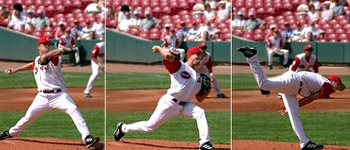 Work–energy theorem
When forces act on a particle while it undergoes a
displacement, the particle's kinetic energy changes by an amount equal to the total work done on
the particle by all the forces.
Work–energy theorem
When forces act on a particle while it undergoes a
displacement, the particle's kinetic energy changes by an amount equal to the total work done on
the particle by all the forces.Wtotal = Change in kinetic energy = KEf - KEi
 Baseball Pitch
The baseball pitcher gives sufficient kinetic energy to the
ball by exerting a greater force on the ball, so he does work on it. To do the greatest possible
amount of work, he applies the greatest possible force over the greatest possible
distance.
Baseball Pitch
The baseball pitcher gives sufficient kinetic energy to the
ball by exerting a greater force on the ball, so he does work on it. To do the greatest possible
amount of work, he applies the greatest possible force over the greatest possible
distance.
According to the work-energy theorem, the net work done by a force in displacing a body, gives the measure of the change in kinetic energy of the body.
When a force does some work on a body, the kinetic energy of the body increases by the same amount. Conversely, when an opposing force is applied to a body, its kinetic energy decreases. The decrease in its kinetic energy is equal to the work done by the body against the retarding force. Thus, work and kinetic energy are equivalent quantities.
We know that work done by a body is given by dW = F.ds
where F = ma. Then, 
The total work done by the force in increasing the velocity of the body from u to v is 

Therefore work done, W = change in the kinetic energy of the body.